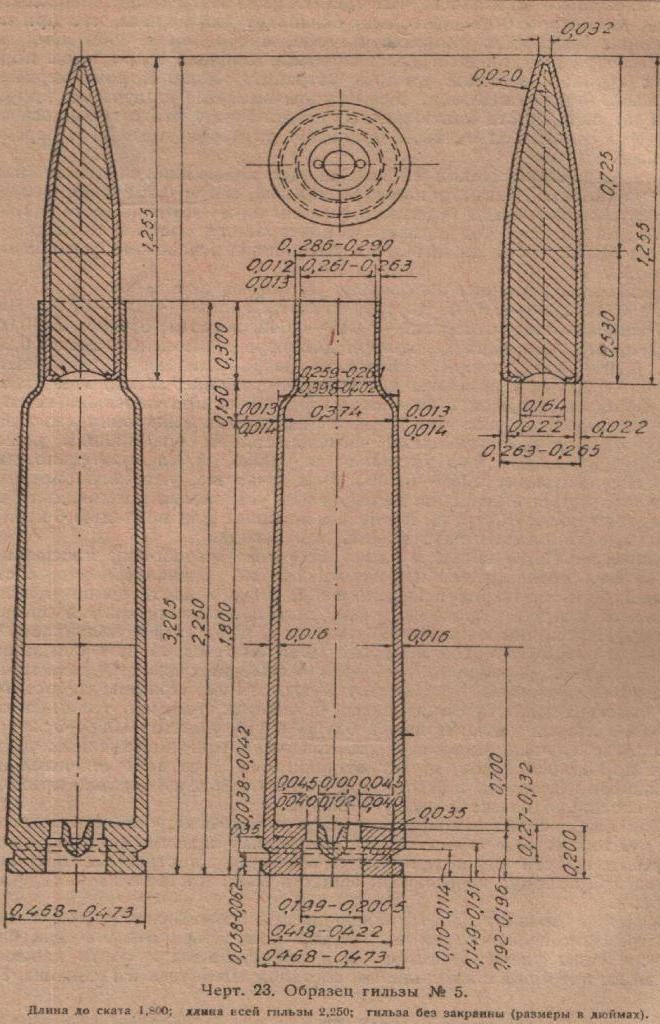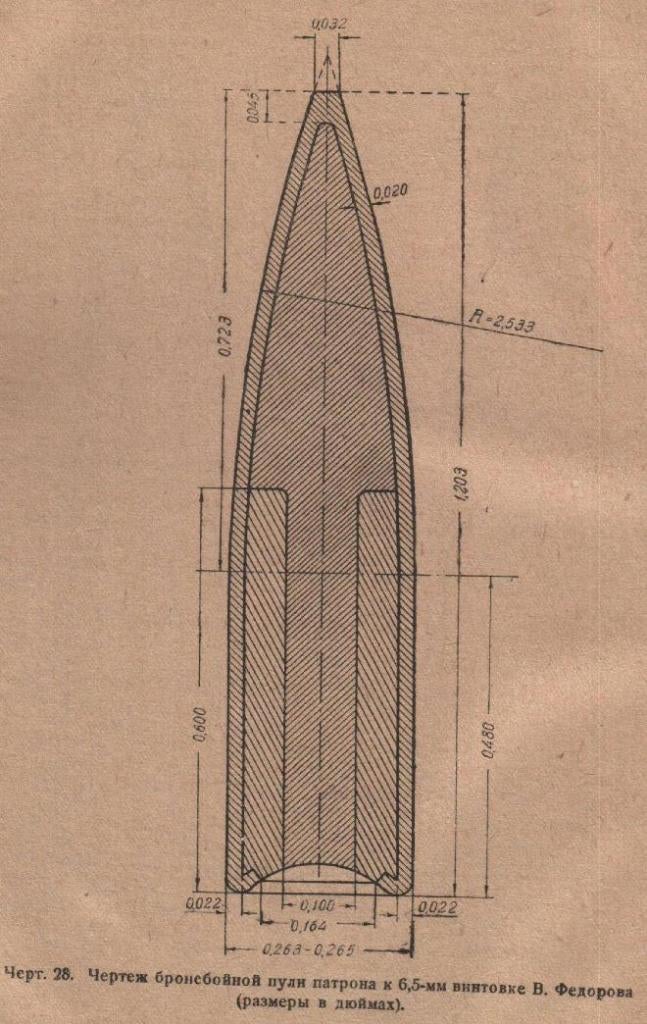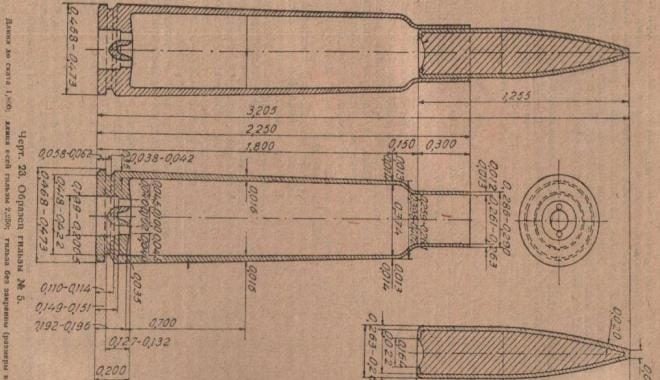Vladimir Fedorov (sometimes written as Fyodorov) was a famous Russian/Soviet firearms designer mostly known for his automatic rifle (Fedorov Avtomat) which is arguably the world’s first issued assault rifle. Besides designing firearms, he was also one of the most advanced Russian researchers of small arms ammunition of his time. The Fedorov Avtomat is chambered in 6.5x50mm Arisaka. However, the rifle was initially designed to be chambered in a completely new 6.5mm cartridge, which was Fedorov’s own design. So the subject of this article is the history of development of that cartridge.

Vladimir Fedorov …

…and his Avtomat
The development of the Avtomat and the cartridge are described by Fedorov himself in one of his books titled “The Gunsmithing on the Verge of the Two Eras” (“Оружейное Дело на Грани Двух Эпох”) published in 1938 in Leningrad (Saint Petersburg). So, this article is based on that book.
Before discussing the actual subject, I’d like to let you know that when this cartridge was being developed (1910-1912) the Russian Empire was using imperial system of measurements. That’s why in his book Fedorov uses mixed designations. Sometimes he says 6.5mm, other times .264 caliber or 2.5 line caliber. The “line” was a measurement unit in Russia which was equal to a tenth of an inch. So one line is .100″, hence the 6.5mm is also referred to as 2.56 line (.256″ bore diameter (by lands)). You may have noticed that sometimes Mosin-Nagant rifles are designated as 3-line rifles (meaning .30 caliber). Note also that Fedorov’s drawings of the cartridge have all the dimensions in inches.
The Need for a New Cartridge
The Russo-Japanese war of 1904-05 revealed that the ability to have high volume and density of fire becomes more and more important. Understanding the need of adopting self-loading and even full auto capable small arms, Fedorov also points out the importance of designing them around a smaller caliber new cartridge. He conducts a number of tests and studies a huge amount of war statistics. In the 4th chapter of the first volume of the mentioned book, Fedorov specifies the advantages of a smaller caliber cartridge:
- Smaller caliber cartridge will be lighter. To achieve a higher firepower, you need to give more ammunition to the troops. So one way of making possible to carry more ammunition within a certain weight limit is to make the cartridges lighter. Fedorov gives an example that if a Russian soldier carries 120 of 7.62mm cartridges, an Italian soldier can carry 162 of 6.5mm Carcano cartridges within the same weight. Those additional 42 cartridges make 168,000 more cartridges carried by an Italian infantry regiment as opposed to a Russian one.
- An automatic rifle will have more parts than a bolt action one so it will be much heavier. Adopting a smaller caliber cartridge will let to decrease the weight of the new rifle, too.
Fedorov was initially designing a self-loading rifle, which first samples were chambered in 7.62x54R. At this point, he gets more convinced that for automatic firearms the existing 7.62mm cartridge is not really suitable. And the need of a smaller caliber rimless cartridge is even more crucial for a full-auto capable firearm.
He also points out some mechanical drawbacks of the 7.62x54R cartridge. Namely, the presence of a rim, thin neck, very shallow head thickness etc.
Fedorov manages to convince the government officials that a search for a new smaller caliber cartridge is important. The question was how small it should be?
External Ballistics
Russians started evaluating the existing experience of foreign armies that have adopted small calibers. Fedorov writes that although there are some sub 6mm experiments done, the smallest issued caliber is the US 6mm Lee Navy. So they chose the 6mm as the smallest caliber and started setting up their own tests. There was also a popular belief that anything smaller than 6mm will have a poor terminal performance despite the possible good external ballistics (flat trajectories). So the 6mm was the smallest one to consider for the military use.
They made a number of different experimental cartridges based on the 7.62x54R. They chose 7mm (2.75 line), 6.5mm (2.56 line) and 6mm (2.36 line) calibers. For each caliber, they made 3 new cartridges – each with a different case length and volume. Each caliber was also tested with three different weight bullets. They made 9 new rifles – one for each experimental cartridge. Another set of 9 rifles was made to equip with pressure testing devices. They fired those cartridges and carefully recorded and analyzed the ballistic data. The result of those tests was a conclusion that the 6mm cartridge with the heaviest bullet and largest case capacity had the best external ballistics (108 grain (7 gram) bullet at about 3280 fps (1000 m/s) muzzle velocity).
Fedorov also says that despite the results, the tests still had some shortcomings. Particularly, for the sake of ease of manufacturing, all the barrels had the same twist rate as the existing 7.62mm rifle – 1:9.45″. So he says that changing the twist rate would be required should they chose one of the new calibers. All the bullets also had the same ogive as the bullet of 7.62mm cartridge and the different weights were achieved by various bearing portion lengths. He considered that to be an issue too.
Terminal Ballistics
Next step was to test the terminal performance of the rounds. Fedorov started with reading doctors’ and surgeons’ reports from the Russo-Japanese war concerning the wound characteristics caused by 6.5mm Arisaka cartridge. He studied reports of 9 different doctors and almost all of them stated that the 6.5mm Arisaka round causes moderate wounds. They wrote that the percentage of soldiers surviving a 6.5mm wound is very high. The doctors even called the Japanese ammunition “humane bullets”.
This reports made Russian government officials believe that smaller calibers are not desirable. However, Fedorov continued his study and proved that the reason why doctors came to that conclusion was that they were comparing the 6.5mm Arisaka to .42 Berdan cartridge. The latter uses lead bullets which result in devastating wounds. So Fedorov proved that it is more about the jacket, and not so much the caliber. The new jacketed bullets stay together and don’t deform like the lead ones thus causing less dramatic wounds. Also, the improvements in medicine might have played a role in high survivability rate of wounded soldiers too. He also says that the wounded soldiers were still incapacitated in the battlefield no matter that the wounds were not always lethal.
By that time the 7.62x54R was a relatively new cartridge too, so Russians didn’t have solid war data on how their own cartridge performs. Fedorov thought that the Russian 7.62mm cartridge should not perform significantly different than the Japanese 6.5mm one. He conducts terminal ballistics tests and proves that 7.62x54R cartridge’s jacketed bullets have similar terminal effects. The tests also show him that 6.5mm and 7mm bullets are equally adequate and comparable to the existing 7.62mm ones, but the 6mm has some disadvantages of penetration at long ranges. Fedorov also says that the difference between 6.5mm and 7mm is non-significant at long ranges. So the choice of 6.5mm caliber becomes more real.
Economic Efficiency of Adopting a New Cartridge
Fedorov opposes the arguments that it won’t be economically efficient to adopt a new cartridge. If the government is going to spend money on adoption of a new rifle, then it would be not too much expensive to adopt a new cartridge along with the rifles. He says that transition to a new rifle and cartridge is a gradual process during which the stockpiles of 7.62mm cartridges will be expended by the army and there is no need to worry about salvaging millions of existing cartridges. He also says that the Mosin rifles will still remain for reserve roles or secondary applications and some of the existing ammunition can be stored along with those rifles.
Setting the Requirements
In chapter 10 of the first volume of his book, he specifies the requirements that the new cartridge should have. He came to these conclusions based on all the previous studies and tests.
- The caliber must be 6.5mm. Interestingly, Fedorov says that he could still go with 6mm, but the lack of significant war experience in any major army of the world with that caliber would make it too risky to choose it or it would require an enormous amount of additional tests. So another reason to choose the 6.5mm caliber was that it was the smallest battle proven one.
- The new cartridge must have maximum average pressures of 3500 atm (about 51,450 PSI).
- It must be rimless. The rimmed cartridge causes feeding issues in automatic weapons and not only makes the guns bulky but also the ammunition packages and boxes.
- Muzzle velocity must be 860 m/s (2820 fps). He admits that it may seem lower velocity for the caliber, but he considered it optimal within a reasonable cartridge case length and use of existing powders. He saw the future of improvement of the MV in developing new powders for the cartridge.
- Sectional density of 25 g/cm². Fedorov says that the tests have revealed that heavier bullets with higher SD have lower MVs but perform better in long range, whereas lighter bullets with lower SD are faster and have flatter trajectories, but have poor long range performance. So he decides that the mentioned sectional density would be a happy medium. If we calculate the SD in a modern way (130gr/7000×0.264²), we’ll get the number of .266.
Fedorov’s #1 Cartridge – The First Version
Based on the above-described requirements, Fedorov designs his first cartridge which he calls #1.

Fedorov’s #1 cartridge
Fedorov writes that he considers the .470 cartridge base/rim diameter to be optimal for automatic firearms with double stack cartridge orientation in the magazines. However, as you can see in the above image, his #1 cartridge is semi-rimmed (.468-.473 base and .482-.487 head diameters). He deliberately designed it semi-rimmed to be able to headspace the cartridge on the rim, which would allow him to easier and quicker make ammo and barrels/chambers to test the ballistics. Fedorov says that at first stages making it headspace on the shoulder would take too much time and require much finer machining. Although, he later admits that the little rim failed several times and cartridges jumped forward into the chamber resulting light primer strikes.
Fedorov decided to keep the overall length approximately close to the dimensions of then new US cartridge (.30-06 Springfield) because he considered that to be the maximum reasonable length. Making the cartridge longer would result in an excessively large mechanism of the automatic firearm.
Fedorov’s #5 Cartridge – The Final Version
By learning from the problems caused by the #1 cartridge, he keeps improving the cartridge’s design until perfecting it in the final #5 version.

Fedorov’s #5 cartridge
The final cartridge was headspaced on the shoulder and it was rimless.
From the very beginning of the development of his cartridge, he writes about the importance of the case body taper for ease of extraction. He finds .470 rim and .400 shoulder to provide an optimal taper. The testing of the #1 cartridge revealed some extraction problems though. He makes a conclusion that the case taper alone isn’t enough for reliable extraction. Fedorov notes that long case body has a huge contact area with the chamber walls. So the friction can sometimes keep the case stuck in the chamber strong enough to cause extraction related malfunctions. That’s one of the reasons why the final #5 case is .300 shorter than the #1 case.
Compared to modern cartridges, Fedorov’s #5 has a longer case and overall length than the .260 Remington, but ballistically (launching a 130gr bullet at 2820 fps) it is about identical to the .260 Rem.
The Bullets
Fedorov also does a lot of experiments with the bullet designs. He comes to a conclusion that the bearing portion of the bullet (which engages the riflings) should not exceed 0.4-0.44 of the bullet’s overall length. He noticed that if exceeded it would cause accuracy issues with the spitzer bullets.
Fedorov also says that the longer the ogive the better. However, the manufacturing processes were not refined enough to make the ogives longer than .750″, which Fedorov considered satisfactory. So by trying different designs, he came up with the final version of the bullet (the left one on the drawing below).

The 130 grain (8.5 gram) bullet was easily reaching the set muzzle velocity requirement of 860 m/s (2820 fps).
Since this was a military cartridge, Fedorov faced the problem with the armor piercing steel cored bullet being lighter. Making it longer to match the weight of the conventional bullet doesn’t solve the problem – longer bullet has a different ballistics too. He says that it completely changes the ballistics and trajectory and he had to find a solution to that problem. So, he came up with a solution that involved making a special steel-tungsten alloy which would have the exact same density as the lead. After several failures, the metallurgists found a way to make the alloy. Thanks to that alloy, Fedorov’s AP bullets had about the same shape and weight as the conventional ones.

Fedorov’s armor piercing bullet
Everything seemed to be good and they were going to proceed with field testing, but the WW1 broke out and the further development of this cartridge was halted. They did make some Fedorov Avtomats which saw a limited service, but those were chambered in 6.5mm Arisaka cartridge, which was easier to obtain than to start manufacturing a new cartridge. Reportedly, Russia even had some significant amount of the Arisaka rifles and its cartridges.
So, there you have it, the brief history of the original cartridge which Fedorov Avtomat was to be chambered in.
 Your Privacy Choices
Your Privacy Choices
